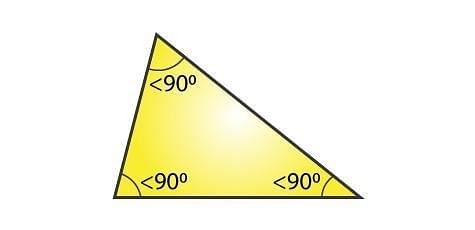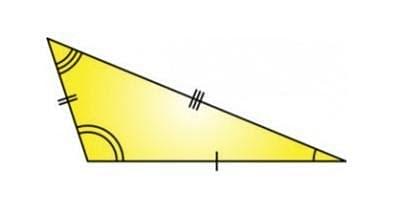
Collegedunia Team Content Curator
Content Curator
There are three types of triangles: Scalene Triangle, Isosceles Triangle, and Equilateral Triangle. Triangles form the foundation stone of geometry. Mainly, their utilisation is maximum in the field of architecture, construction, interior designing. Although, the concept of triangles holds crucial importance for those in the field of engineering. Triangles have several key advantages for architects, such as their commonality, structural soundness, and ease of use every day. A triangle’s strength comes from its shape, which spreads forces evenly.
| Table of Content |
| Also, read: | |
|---|---|
What is a Triangle?
A triangle is defined as a specific type of two dimensional polygon having only three sides, three vertices and three angles. Based on the lengths and measures of the sides and angles of a triangle, there are six basic types of triangles.
Triangles can have the same sides or they can have different sides. They can have the same angles or they can have different angles. Angles can be greater than, less than, or equal to 90 degrees.
A triangle having the same angle and different side length is known as a similar triangle. Therefore, the bigger triangle and the smaller triangle always have the same side ratio. The simplest polygon is the triangle. Polygons are closed, flat, two-dimensional shapes that have many corners. Three corners are necessary to make a polygon since one or two corners cannot form a closed shape.
Angle sum is the property of triangles that the sum of all internal angles equals 180°.
Important Terms Related to Triangles
Median: A median is the line segment connecting the vertex of the triangle to the midpoint of the opposite side of the triangle.
Angle Bisector: An angle bisector is also defined as the angle in an equilateral triangle or the non-congruent angle in an isosceles triangle.
Centroid: An intersection of a triangle’s medians (the lines connecting its vertex to its opposite vertex) is a triangle’s centroid. It divides each of the medians in the ratio 2:1, which means it is located at 13% of the distance between each side.
Altitude: A triangle’s altitude is formed by a line segment that crosses through its vertex and is perpendicular to the line containing its base. The extended base of the altitude is found where it crosses the altitude.
Orthocentre: A triangle's orthocentre is the intersection of the perpendiculars drawn from its vertices to its opposite sides.
Types of Triangles
Refer to the table below for the types of triangles and their properties.
| Types | Name of Triangle | Properties of Triangles | Diagrams |
|---|---|---|---|
| On the basis of sides | Scalene Triangle |
Not all sides are non congruent
|
|
| On the basis of sides | Isosceles Triangle |
|
|
| On the basis of sides | Equilateral Triangle |
|
|
| On the basis of interior angles | Acute Triangle |
|  |
| On the basis of interior angles | Obtuse Triangle |
|
|
| On the basis of interior angles | Right Triangle |
|
|
Things to Remember
- An apex angle is a triangle whose two base angles are not congruent.
- Area, A = ½ × base × height
- By dividing the base in half and the apex angle in half, an isosceles triangle’s height is divided in half as well.
- From the median, we can get two equal sides.
- Circumcentre lies outside the triangle, if the angle is 90°.
- An isosceles triangle is divided into two equal triangles by the median.
- Median is the line which triangles into two.
- Orthocentre, circumcentre, incenter and centroid coincide at the same point.
- A circumcircle’s radius is always half its hypotenuse, and its centre is the hypotenuse’s midpoint.
- The right angle of the hypotenuse produces three similar triangles.
Sample Questions
Ques. With the help of the following figure prove that BF/FE = BE/EC. Given that DE // AC and DF // AE. (3 Marks)

Ans. From the above triangle ABC, we can see that.
Given,
DE // AC
DF // AE
Prove: BBF/FE = BE/EC
Bu using Basic Proportionality Theorem,
BD/DA = BE/EC………. Equation (i)
Again applying Basic Proportionality Theorem,
BD/DA = BF/FE………. Equation (ii)
From equation (i) and equation (ii),
BE/EC = BF/FE
Hence proved.
Ques. A vertical pole of length 6 metre casts a shadow 4 metre long on the ground and at the same time a tower casts a shadow 28 metre long. Find the height of the tower. (4 Marks)
Ans. Given,
Length of the vertical pole, L1 = 6 m
Shadow of the pole, s = 4 m
Let the height of the tower be ‘x' metres.
Length of the shadow of the tower, L2= 28 m
In ΔABC and ΔDFE,
∠C = ∠E (angle of elevation)
∠B = ∠F = 90°
Using AA similarity criterion,
ΔABC ~ ΔDFE
The corresponding sides of two similar triangles are proportional.
AB/DF = BC/EF
6/x = 4/28
x = (6 ×28)/4
x = 6 × 7
x = 42
Hence, the height of the tower = 42 m.
| Also, read: | |
Ques. Find PR, if ΔABC ~ ΔQRP, area (ΔABC) / area (ΔPQR) = 9/4 , AB = 18 cm and BC = 15 cm. (4 Marks)
Ans. Given that ΔABC ~ ΔQRP.
Area (ΔABC) / Area (ΔQRP) =9/4
AB = 18 cm and BC = 15 cm
The ratio of the areas of two similar triangles is equal to the square of the ratio of their corresponding sides.
Area (ΔABC) / Area (ΔQRP) = BC2/RP2
9/4 = (15)2/RP2
RP2 = (4/9) × 225
PR2 = 100
So,
PR = 10 cm
Also, read: Area of a Triangle
Ques. Find the value of x, if DE || BC in ΔABC. (3 Marks)
Ans. In ΔABC,
Given: DE || BC
Find: x
Using Thales’ Theorem, we get,
AD/BD = AE/EC
x/x+1 = x+3/x+5
x(x + 5) = (x + 3)(x + 1)
x2 + 5x = x2 + 3x + x + 3
x2 + 5x – x2 – 3x – x = 3
x = 3
So, the value of x is 3 cm.
Ques. Hypotenuse of a right triangle is 25 cm and out of the remaining two sides, one is longer than the other by 5 cm. Find the lengths of the other two sides. (4 Marks)
Ans. Let the base, AB = x cm
Altitude, BC = (x + 5) cm
In right Δ,
Using Pythagoras’ theorem
AB2 + BC2 = AC2
(x)2 + (x + 5)2 = 252
x2 + x2 + 10x + 25 – 625 = 0
2x2 + 10x – 600 = 0
x2 + 5x – 300 = 0 (Dividing both sides by 2)
x2 + 20x – 15x – 300 = 0
x(x + 20) – 15(x + 20) = 0
(x – 15)(x + 20) = 0
x – 15 = 0 or x + 20 = 0
x = 15 or x = -20
The base cannot be negative.
So,
x = 15 cm
Length of the other side = 15 + 5 = 20 cm
Two sides are = 15 cm and 20 cm.
Ques. Prove that ΔADE ~ ΔGCF, if AB ⊥ BC, FG ⊥ BC and DE ⊥ AC. (3 Marks)
Ans. In right ΔABC,
∠A + ∠C = 90° (i)
In right ΔAED,
∠A + ∠2 = 90°
From (i) and (ii), ∠C = ∠2
Similarly, ∠A = ∠1
In ΔADE & ΔGCF
∠A = 1 (Proved)
∠C = 2 (Proved)
∠AED = ∠GFC
∴ ΔADE – ΔGCF (Hence Proved)
Find more sample questions here: Triangles Important Questions












Comments